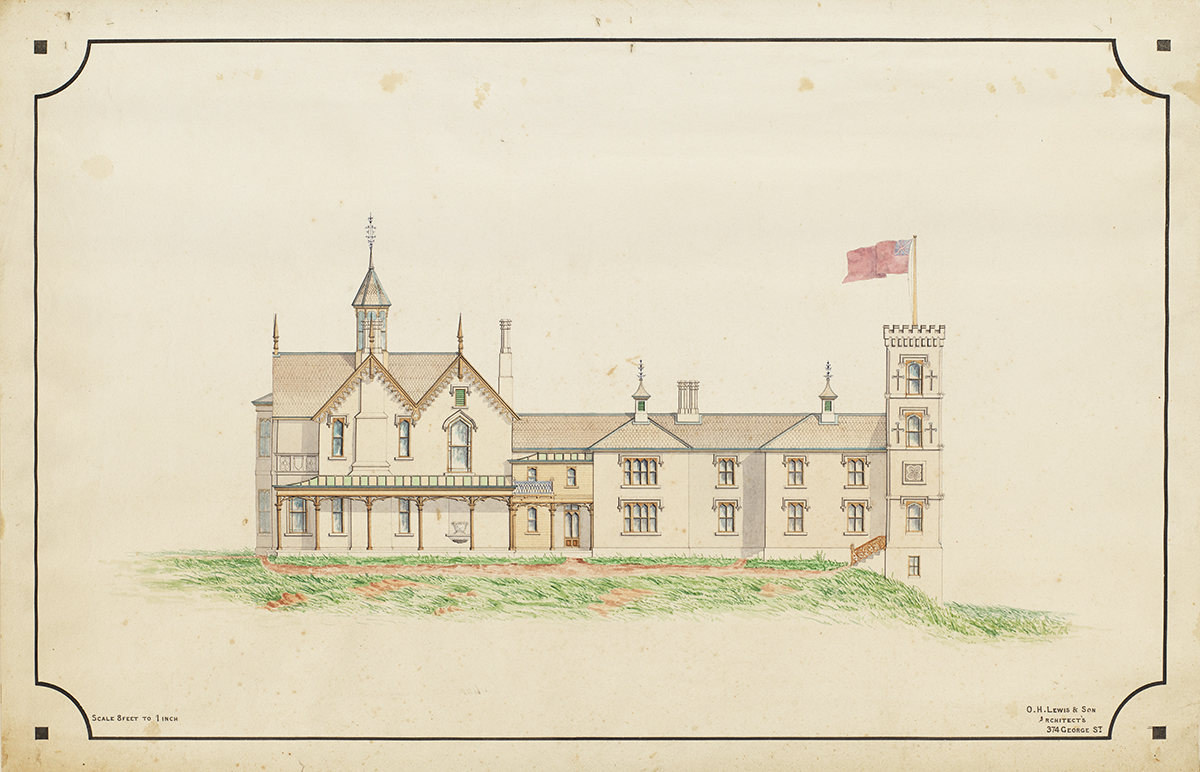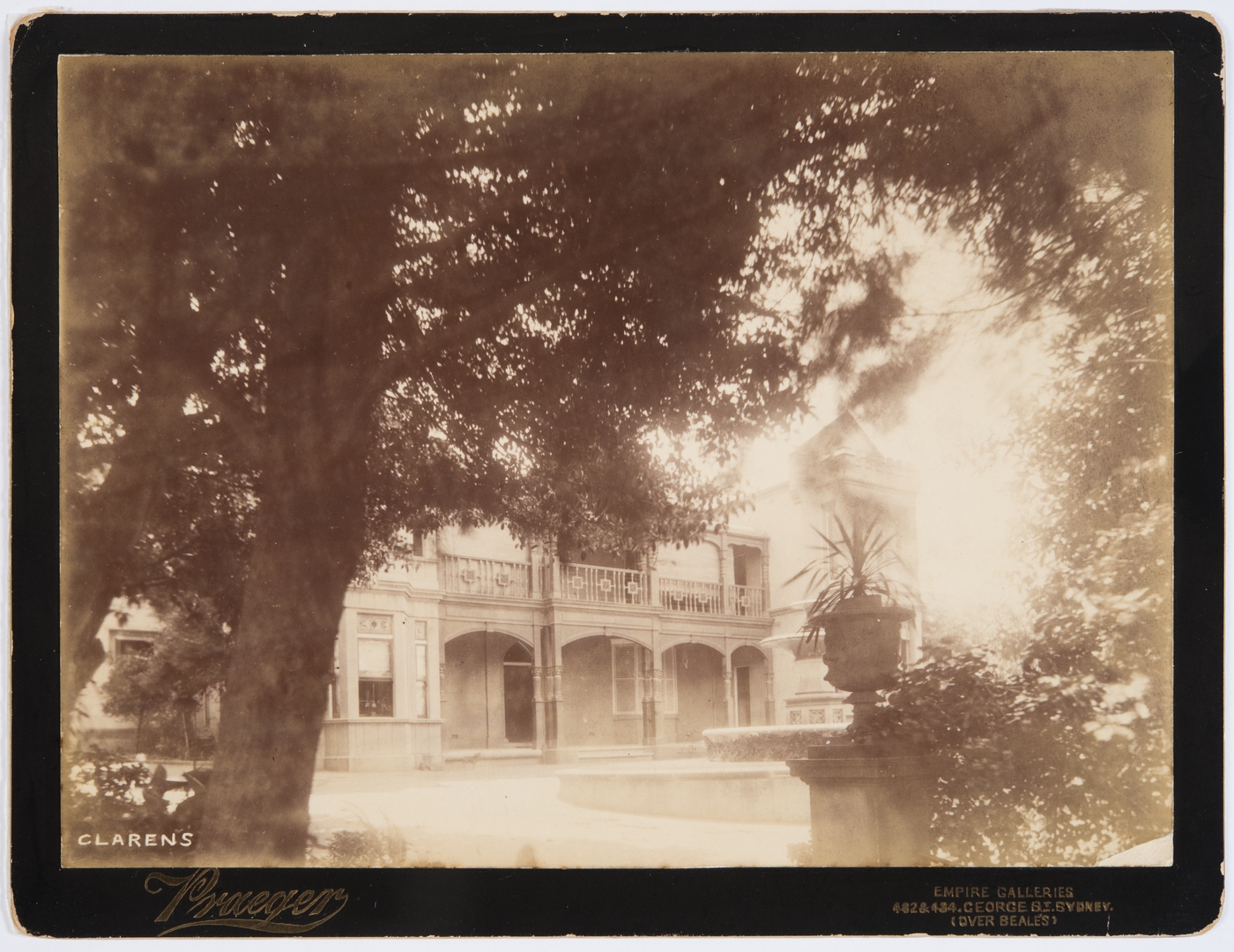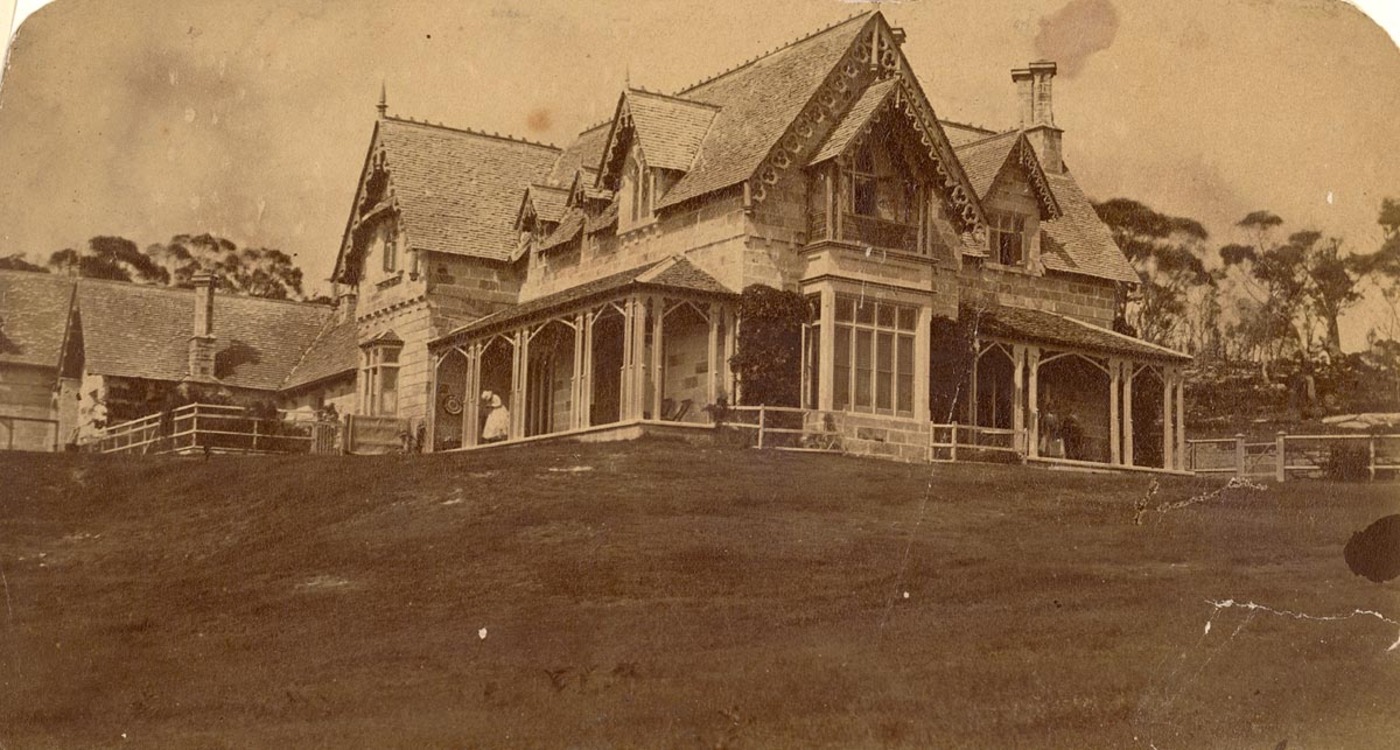The Dictionary of Sydney was archived in 2021.
Clairvaux House
Citation
Persistent URL for this entry
To cite this entry in text
To cite this entry in a Wikipedia footnote citation
To cite this entry as a Wikipedia External link
Clairvaux House
Through buildings we reach other imaginations very directly, for buildings are both works of art and evidence of living – if and only if the buildings survive. [1]
Clairvaux House [media]is yet another of Sydney's grand Victorian homes lost to us but for the memory. Built on land purchased from the Wentworth Estate around 1871, [2] Clairvaux estate survived into the first half of the twentieth century when it underwent three subdivisions before being demolished in 1929 to make way for six residential sites.
The Dalley years
Clairvaux House [media]was designed by Lewis & Sons architects for William Bede Dalley. [3] Dalley rose from humble beginnings to become a significant politician and lawyer in Sydney. His Irish parents, John Dalley and Catherine Spillane, were both convicts. A dedicated Catholic, he was educated at St Mary's seminary. Although Catholic he married Eleanor Long, an Anglican, in 1872 at St John's Church of England, Darlinghurst. Eleanor was one of three daughters of William Long, an ex-convict, politician and wealthy wine and spirit merchant.
Once completed, the Dalley's moved into the newly constructed Clairvaux House where they established a fashionable abode. An article from the Albury Banner and Wodonga Express in 1911 describes how,
In this ideally situated retreat…[Dalley] entertained with characteristic and lively wit his famous political, professional, artistic, and social contemporaries and distinguished visitors to Sydney. [4]
But Dalley's happiness was to last less than a decade. On 17 January 1881 Eleanor died of typhoid fever at Clairvaux. Dalley sold the property a month later on 18 February 1881, perhaps not being able to bear to live there anymore. Initially, he retired from public life and spent time with his six children. In 1882 he bought land in Manly across the bay from Clairvaux and built another impressive mansion, Marinella.
The Bennett years
Dalley sold his estate to Alfred Bennett for £6,000 pounds. Alfred was one of the sons of Samuel Bennett, the founder of the Australian Town and Country Journal and the Evening News . After completing his education at Pendrill's School, Glebe Point, Alfred followed his father into publishing, eventually taking control of the business in 1878 when his father died.
For more than thirty years following Alfred's death, Clairvaux remained in the Bennett family. A glimpse into family life at Clairvaux comes from newspapers of the day with reports of home births and deaths and advertisements for staff including a 'good cook and laundress,' a 'butler wanted immediately' and 'an assistant nurse and a needlewoman'. An 1893 report tells of a burglary at the house, while happier occasions include parties. [5]
Mrs Bennett's surprise
One of the well-healed pleasures of the late 1800s were 'surprise parties'. Unlike the modern tradition of guests gathering at a home in advance to surprise the unknowing host/hostess of the occasion, surprise parties of yesteryear saw guests descending upon a home unannounced. In 1887, Mr and Mrs Bennett found themselves all of a sudden participating in one of these 'most agreeable social gatherings':
Mr. Bennett's drawing room was made the scene of an invasion of an unexpected but perfectly peaceful and joyous character, which was submitted to with grace and suavity…Mrs Bennett set an excellent example to those whose houses and properties may be taken possession of in similar circumstances, by receiving the invading forces in a manner that showed she was heartily glad to see them…a room was cleared of furniture and converted into a ballroom, where the musicians accompanying the party were stationed with orders to keep continually playing dance music…In the drawing room several of the lady and gentlemen visitors performed music, instrumental and vocal…Another member of the party gave some most amusing imitations of living and dead politicians…After some four hours spent in this agreeable manner, the surprise party 'folded their tents like the Arabs'…(and departed with) a ringing cheer as the coaches left.' [6]
In 1901, Alfred died suddenly while attending as a witness at the courthouse, Picton. He left a widow, two sons and three daughters. Having left the publishing business in 1894, Bennett spent a great deal of time involved in dairying, agriculture and stock raising. He was the first dairyman in the Camden area to induce dairymen to make cattle ponds of dams. [7]
Lady Isabella Martin
The 1902/3 council assessment lists Clarivaux House for the first time in the name of Mrs Alfred Bennett. At some stage the Bennett family moved out of the property, for during Mrs Bennett's period of ownership, Clairvaux was leased to Lady Isabella Martin. Lady Martin was the sister of Eleanor Long, nee Daley and would have been most familiar with the property.
Lady Martin [media]was a strong minded woman. Married to James Martin, the politician and Chief Justice, she bore 15 children. She became unhappy with her relationship [media]with Martin and was frustrated [media]with the cramped conditions of their home, Clarens, in Potts Point. In 1880, after the death of two of their children, things came to a head and by 1882 she had moved out. [8] Being independently wealthy she rented Greycliffe in Vaucluse, then Woollahra House in 1889, before arriving at Clairvaux sometime after 1902. Lady Martin remained at Clairvaux until her death in March 1909.
Dalley Mansion Estate
By the early twentieth century many old estates were being subdivided. The large grounds were too expensive to maintain and as Sydney expanded, land became a premium. There are three subdivisions associated with Clairvaux House, occurring in 1910, 1911 and 1929.
In November 1910, a portion of the Clairvaux lands amounting to approximately half the area, subdivided as the Dalley Mansions Estate, was offered for sale as 'Clairvaux House and 7 Villa sites'. [9]
In 1911, Clairvaux House was sold with the intent to subdivide the remaining property. [10] The land was subdivided into 36 lots and sold as the Dalley Mansion Estate. [11] Clairvaux was subsequently referred to as Dalley Mansion.
The estate will be known as the 'Dalley Mansion'. Clairvaux will be submitted separately on an adequate garden area…The wise will [sic] visit Clairvaux see for themselves and come to prompt decision. [12]
Following the subdivision and sale of most of the associated lands, the owner of Clairvaux House was solicitor William Arnott. The Arnotts sold the house in 1921 and it was purchased in the name of Ada Eveline Johnston. Mrs Johnston and her husband William Roderick Johnston did not remain in residence at Clairvaux for more than a few years.
School residence for boarders
In 1923 the house was leased by school master Mr H Wilshire of Sydney Grammar School. Wilshire requested permission from the school to use it as boarding house for boys. Headmaster Arthur Lucas did not support the application because he did not believe in the 'spiritualism professed by Wilshire and others' and thought that their efforts to communicate with the dead would lead to 'strange' and 'unhealthy' conditions in the home. [13] Nevertheless, the school's trustees approved the lease. The president of the Committee of old Sydneians' Union commented in 1924 that the 'accommodation was excellent and suitable for from 40 to 50 boys'. [14]
Final chapter
By 1929 the romance was over. Mrs Johnston retained Clairvaux until the subdivision and sale of the property in 1929. Clairvaux House was advertised for 'demolition and removal'. The 'building of stone, slate roof, cedar fittings, doors, window frames, two stories and tower' [15] were all to be gone within a month. The property initially failed to be cleared and was passed in at the amount of fifty pounds. [16] A few days later the price of fifty pounds had been accepted and the house was no more.' [17] By February 1929 the site had been subdivided. 'Clairvaux House Estate' was for sale as six 'exceptionally fine residential sites situate[d] in the dress circle of Vaucluse, and having frontages to Dalley Avenue'. [18]
It is fitting that the final words be given over to the description of this once fine house:
… a stone structure, slate roofed, conceived and executed on a generous scale... flanked by a three-storied stone tower, surmounted with machicolations and gargoyles, and relieved with various stone carvings – heads, fruits, ferns, clusters etc. All around the main building are similar sculptures…the most striking of which are…perhaps the clusters of fruits and flowers running around the façade. Many of the carvings are symbolical, the usual style of those found on Gothic cathedrals. Ornately carved stone pillars flank the main driveway, and a broad gravel path leads up to the old ogive porch, guarded by a benign figure of the Virgin Mary.' [19]
Further reading
'A Romance of Dalley Mansion Estate,' real estate pamphlet. Sydney, Hardie and Gorman, 1911. http://nla.gov.au/nla.cat-vn1527687
Jervis, James and Vince Kelly. The History of Woollahra: A Record of Events 1788–1960 and A Centenary of Local Government. Woollahra, NSW: Municipal Council of Woollahra, 1960.
Marr, David. 'Beauty May Not Be Enough.' Demolished House of Sydney, edited by Joy Hughes. Sydney, NSW: Historic Houses Trust of NSW, 1999.
Notes
[1] David Marr, 'Beauty May Not Be Enough' in Demolished House of Sydney, edited by Joy Hughes (Sydney, NSW: Historic Houses Trust of NSW, 1999)
[2] James Jervis and Vince Kelly, The History of Woollahra: A Record of Events 1788–1960 and A Centenary of Local Government (Woollahra, NSW: Municipal Council of Woollahra, 1960), 68
[3] James Jervis and Vince Kelly, The History of Woollahra: A Record of Events 1788–1960 and A Centenary of Local Government (Woollahra, NSW: Municipal Council of Woollahra, 1960), 68
[4] Albury Banner and Wodonga Express, NSW, 16 June 1911, 35
[5] The Sydney Morning Herald, 18 January 1881, 1, available online http://trove.nla.gov.au/ndp/del/article/13479788; Alfred Bennett’s wife gave birth of a son, born prematurely that survived three hours. The Sydney Morning Herald, 23 January 1882, 1, available onlinehttp://trove.nla.gov.au/ndp/del/article/13503560; 'Wanted, married couple, man as gardener (experienced), wife good cook and laundress: references required,' Evening News, 11 November 1884, 5, available onlinehttp://trove.nla.gov.au/ndp/del/article/107278428; 'Young man as butler or indoor servant wanted'Evening News, 28 May 1892, 1, available online http://trove.nla.gov.au/ndp/del/article/112940887; 'Respectable young girl, as nurse and to assist, wanted at Clairvaux, Rose Bay; Protestant,' Evening News, 12 April 1892, 1, http://trove.nla.gov.au/ndp/del/article/112947617; 'The residence of Mr Alfred Bennett, Clairvaux, Rose Bay, was broken into and robbed,' Evening News, 22 November 1893, 3, available online, http://trove.nla.gov.au/ndp/del/article/112935191
[6] Evening News, 4 July 1887, 4
[7] 'The Late Mr. Alfred Bennett', Sydney Morning Herald, 4 February 1901, 4
[8] 'James (later Sir James) Martin' by JM Bennett in The Premiers of New South Wales, Volume 1, 1856–1901, edited by D Clune and K Turner (Annandale, NSW: The Federation Press, 2006), 116
[9] Richardson & Wrench, 'Vaucluse, Rose Bay, Clairvaux House & 7 villa sites [cartographic material] / for auction sale at the rooms 98 Pitt St., Friday 18th November 1910 at 11.30 a.m., Richardson & Wrench Ltd., auctioneers,' map (Sydney: F Cunninghame & Co, Litho, 1910) http://nla.gov.au/nla.cat-vn808117
[10] The Gundagai Times and Tumut, Adelong and Murrumbidgee District Advertiser, 13 June 2011, 2
[11] 'A Romance of Dalley Mansion Estate,' real estate pamphlet (Sydney, Hardie and Gorman, 1911), http://nla.gov.au/nla.cat-vn1527687
[12] Watchman, Sydney, 28 September 1911, 9
[13] C Turney, Grammar, A History of Sydney Grammar School 1819–1988 (Allen & Unwin 1989), 168
[14] Minutes of a meeting of the Old Sydneians' Union Committee of 8 April 1924, minute books, Sydney Grammar School Archives, ASSO/10 WCB 5, ITEM/0277
[15] The Sydney Morning Herald, 24 November 1928, 24
[16] Sunday Times, Sydney, 9 December 1928, 14
[17] Construction and Local Government Journal: The Weekly Supplement to Building and the Australasian Engineer, edited by George A Taylor 4, no 1135 (12 December, 1929): 19. Available online, http://trove.nla.gov.au/ndp/del/title/449, viewed 14 January 2016
[18] Sunday Times, Sydney, 3 February 1929, 10
[19] The Sydney Morning Herald, 28 December 1923, 6
.







